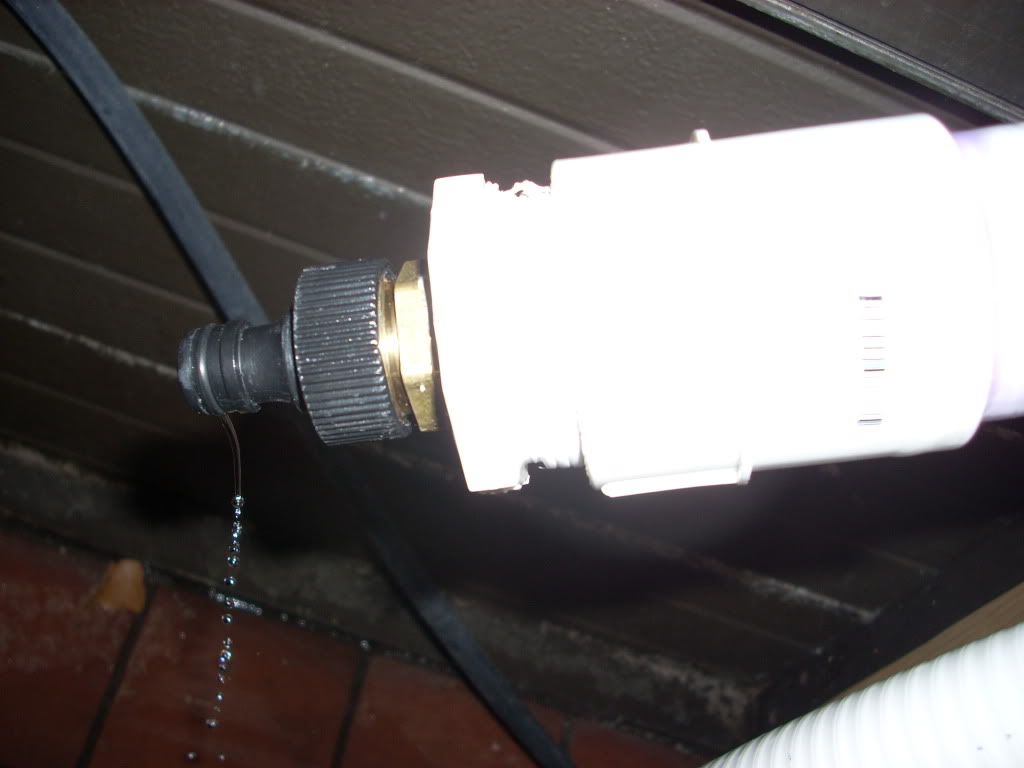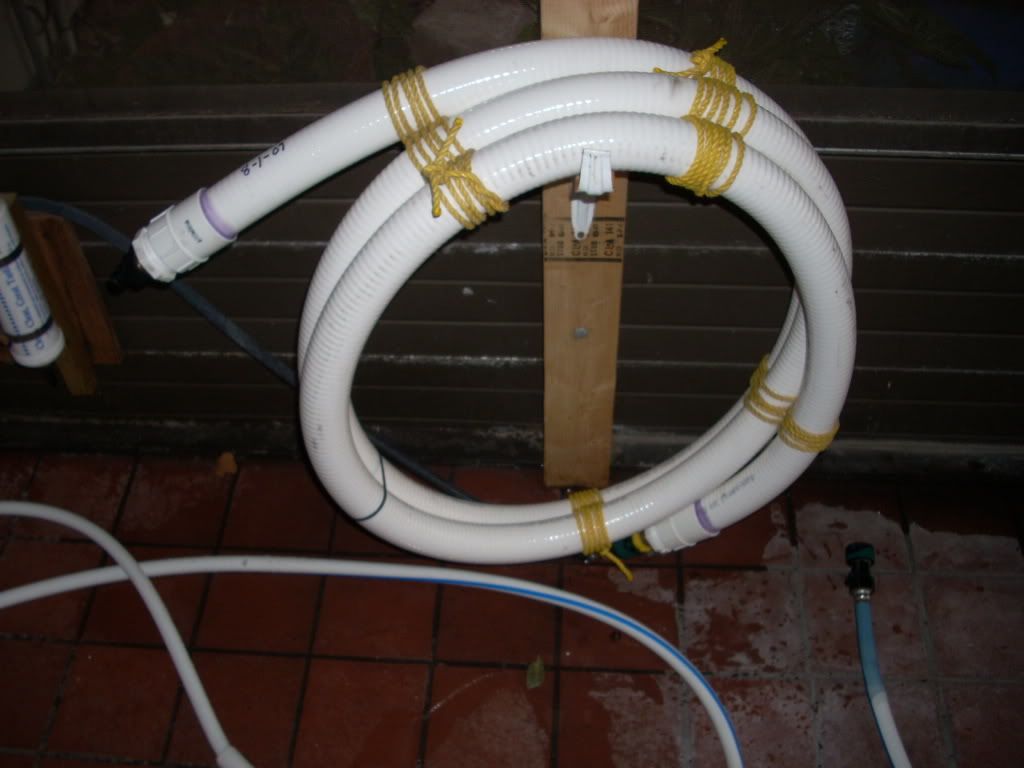Originally posted by Zulaab
View Post
Announcement
Collapse
No announcement yet.
the latest carbon filter
Collapse
X
-
My Kiku female last night dropped her tube (10 min before lights out.. I dont know if she started holding last night or not..)
This morning.. she was at it again with the other male in the tank.
Hopefully in a few month when I can split the Chilambo from the Kiku, the Chilambo will start breeding. I have seen attempts but the male Kiku will run in there and stop all action...
The Chilambo just dont have a chance at it.
What fish do Jesper have
180 WC T. Moorii Chilambo +1 Petro trewavasae.
110 Cyps, WC Xeno Spilopterus Kipili WC/F1/F2 T. sp red Kiku
58 S. Decorus
"The problem with socialism is that eventually you run out of other people's money." -Margaret Thatcher
Comment
-
whole house carbon filterOriginally posted by Matt in Houston View PostI think Im going to attempt this as well but I think I would rather make a shorter section of carbon filtration and replace it yearly then have a 15ft heavy monster. I'm thinking 5ft? Any thoughts?I ate my fish that died.
Comment
-
I see....well is there a chart or something that can show us how much carbon is needed to remove a certain amount of chlorine?
Doesnt the carbon hose distance also need to take into consideration how much chlorine is in the water and the flow of the water?
In other words, how did we get to the 15ft standard?
Here is an interesting article I found googling chlorine and carbon.
Activated Carbon Filters
Using the same technology as the activated carbon filtration used in many aquarium filters, Activated Carbon can be used to filter the water right from your tap. Many people use simple carbon filters on their kitchen tap, to remove nasty tastes and odors from their drinking water. The same filter units can be used to filter the water before adding it to the aquarium. Many of these tap filters only offically claim to remove the "taste and odor" of the chlorine, making no promise of how much chlorine is really removed. Other carbon filter units specifically claim to be able remove chlorine but the amount of chlorine they remove depends on the quality, size, and flow-rate of the filter, and the amount of chlorine in the tap water to begin with.
In addition to the effectiveness concerns regarding the removal of chlorine, is the issue of chloramine. Very few carbon filters can remove chloramine. The chlorine-ammonia bond prevents standard carbon from removing the chlorine. Some new carbon filter units are now using a special "Catalytic" Activated Carbon. This catalytic carbon can break the chlorine-ammonia bond, and absorb the chlorine. BUT! They leave the ammonia free, which we've already said is a bad thing. I've seen one tap-water filter that added a special ammonia absorbing compound (zeolite) in addition to the carbon. But zeolite has a fairly small ammonia absorbing capacity so it needs frequent replacement, and it isn't found in any common tap-water filters. Without the additional ammonia absorbing compounds, you must use some other treatment to remove the ammonia.
There are several other problems regarding the use of carbon filtration. First, the effectiveness of the chlorine removal is highly dependant on the flow rate. Filters will commonly list the recommended flow. One high-quality filter states "At 1 gpm (gallon per minute), with an input of 3ppm, the output will contain .5ppm". As you increase the water flow thru the filter, the effectiveness drops. Some filters contain flow-restrictors to prevent you from increasing the flow above the recommended. In either case, to allow effective filtering, your flow rate is limited.
Another problem is that the carbon filter can only remove a certain amount of chlorine. After the filter has treated that certain number of gallons, it's effectiveness is greatly reduced. Some of the more high-tech filters contain electronic monitors, that inform you when it's time to change the filter element. But if you keep using the filter past it's stated life, you are gambling with your fish's lives.
------------------
I went to lowes and looked around in the plumbing department...they have two types of hoses, one is blue and the other is white...both are spa/pool hoses with diameters of 1.5". I saw a ball valve that had a 1.5" threaded ends, and I found 1.5" threaded end caps...I guess you use that to cap the spa hose but how do you convert 1.5" to the size of the tubing on the python? Drill a hole in the cap?Last edited by Matt in Houston; 09-07-2009, 04:17 PM.15g column BB low-tech driftwood/planted - Dwarf Puffer Tank :lupe:
Comment
-
Matt.. The way 15ft was reached was because John (fshfrk) has made several, both 1" white spa hose units and now 1.5" white spa hose units..
Why 15ft ? because you want to be able to let the water keep contact long enough that EVERYTHING is removed, not just a partial removal. I have personally tested John's tap water which comes out 1.0ppm free Chlorine and 3.5ppm Total which means that there is both free chlorine and Chloramines in his water supply (2.5ppm Chloramines).
The reason John went to the 1.5" spa hose was for water flow. Its simply to slow with a 1" hose. Increase the hose size and the amount of activated carbon added to the system gives you a faster flow. I imagine somewhere double the speed.
1" gives you 100gph and the 1.5" gives you about 200gph. (I use a 1.5" and I get about 200gph at my house.) I am lucky. I only have to remove 1.25ppm free chlorine so I have almost nothing to remove. At fshfrk's house he has a ton of stuff to remove and it does the job.
Both John and I use commercial Chlorine testers to ensure that we are taking 100% out.
I dont have a camera right now or else I would have taken a picture of mine to show. This unit is what John made for me. Hopefully John will jump in here and post pictures of his 1.5" unit.
What fish do Jesper have
180 WC T. Moorii Chilambo +1 Petro trewavasae.
110 Cyps, WC Xeno Spilopterus Kipili WC/F1/F2 T. sp red Kiku
58 S. Decorus
"The problem with socialism is that eventually you run out of other people's money." -Margaret Thatcher
Comment
-
The longer the carbon section of hose the better contact time of course....I guess my thinking is if you have very little chlorine in your particular water...is the 15ft really neccesary. As you have stated, at John's house it is very much needed.
Each person would need to test his or her water to know exactly how long they should make it I can imagine...heck maybe some people may need 20ft if they have more chlorine than John.
I need to get a test kit and find out what I've got out here. I also like the idea of the larger diameter 1.5" hose. Thats the biggest stuff they had at lowes in the plumbing department.
Thanks for the help...15g column BB low-tech driftwood/planted - Dwarf Puffer Tank :lupe:
Comment
-
Test kit is the way to go to make sure.
I have my a whole house carbon bottle and I still use prime. I'm to scared of what the city does sometimes.
Mistakes happen. There are a lot of articles on the internet about city workers dumping all kinds of chemical into our water supply.
I can link some if you are interested but google works all the same.I ate my fish that died.
Comment
-
no I dont think at my house I need all 15ft but what if there is a change down the road.. second by having a long hose you ensure that you are not needing to refill after like 6 months and you didnt test and your carbon has been exhausted. I test every 3 months to make sure. My first test (not done my second 3 month test yet) was clean.
What fish do Jesper have
180 WC T. Moorii Chilambo +1 Petro trewavasae.
110 Cyps, WC Xeno Spilopterus Kipili WC/F1/F2 T. sp red Kiku
58 S. Decorus
"The problem with socialism is that eventually you run out of other people's money." -Margaret Thatcher
Comment
-
1 1/2" to 1" adapter, 1" bushing to 3/4" pipe thread, and brass 3/4" male pipe thread to 3/4" hose thread. (used to use the pvc but they leak) Put the quick connects on so I can switch input to output and back flush for 5 minutes. If you run this back flush water in a bucket you can see why this is important. It's nasty stuff. after I flush it I leave the hose on that end and run it that direction for 5-6 weeks till I do it again.
bottom pic is where I turn it on and off


 200
200
200
200
150
135
75
55
55
Trophs & Petros ONLY
Comment
-
In the winter I will bring this in the house and put it in the guest bath tub. you won't be able to see it with the curtain shut. So I can get water temp to 80 degrees. I have the quick connect on the faucet in the bathroom.
Make sure you use teflon tape on all threaded connections. Use primer and fresh glue because this thing builds up alot of pressure. It will make a mess if you have it in the house when a coupling pops.
Jesper is right the 1" version is way to slow for large tanks so I use it for the smaller 30 gal tanks.
I have been wanting to put a pre filter on this. somthing like pool filter sand.
Want to get some catilytic carbon but this filter does remove my chlorimines now. That all could change when Houston city water arrives in 6 months or so.200
200
200
150
135
75
55
55
Trophs & Petros ONLY
Comment
-
Got a letter yesterday notifing me that the conversion to surface water is 1-2 months away. The chloramines are here. Called bridgestone mud district they said go to Texas commision on enviromental quality web site. www.tceq.state.tx.us I don't see any thing helpfull as far as chlorine removal with carbon. Maybe ya'll could find somthing?200
200
200
150
135
75
55
55
Trophs & Petros ONLY
Comment
-
couldn't find anything either.....Originally posted by fshfrk View PostGot a letter yesterday notifing me that the conversion to surface water is 1-2 months away. The chloramines are here. Called bridgestone mud district they said go to Texas commision on enviromental quality web site. www.tceq.state.tx.us I don't see any thing helpfull as far as chlorine removal with carbon. Maybe ya'll could find somthing?
Comment
Comment